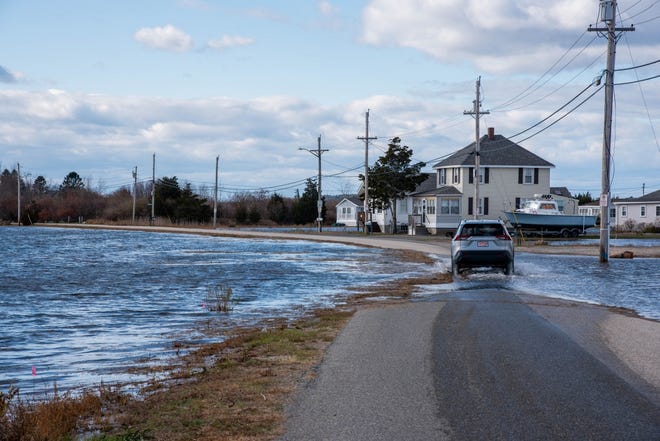On the Forefront

With contributing writers Michelle Morrissey ’97 and Robbin Ray ’82
rom the roads we drive on to our teens’ safety, and from the lingering COVID-19 pandemic to the ways the climate crisis affects the environment around us, research being done by UNH faculty, staff and students is advancing the well-being of our state, the world, and all of us in our daily lives.
The money is impressive, says Marian McCord, senior vice provost of research, economic engagement and outreach, but the funding is about much than a dollar figure. “These grants support our scholars as they tackle problems we all face, such as climate change, the COVID pandemic, substance abuse and mental health challenges,” says McCord, who stepped into her role at UNH just weeks before the coronavirus was declared a global crisis. She notes that while the world seemed to shutter as the virus took hold, UNH researchers persevered and adapted. “For the second year, our scholars overcame the significant challenges of the pandemic to submit competitive research proposals for work that aims to understand and improve our world.”

And the impact of this funding is felt far beyond labs and libraries: Knowledge generated through these projects improves UNH undergraduate and graduate student learning by bringing innovative ideas and new theories into the classroom, McCord notes.
Expanding competitive funding for research is essential to maintaining the Carnegie Classification R1 status, which puts UNH in the top tier of research universities nationwide, and advancing an institutional goal to become a top-25 public university. External grants and awards fund specific research projects and are carefully accounted for through a robust compliance process mandated by grantors. In addition to major scientific instruments and laboratory supplies, a significant share of external funding supports scholarships and salaries for graduate and undergraduate students, post-doctoral scholars, staff and faculty researchers.
Although this research funding comes to UNH, its impact is felt throughout the state — and beyond. “It’s our mission and responsibility as a public institution to transfer our knowledge for the good of those we serve,” McCord says. She points to entities such as Cooperative Extension, UNHInnovation, the NH Agricultural Experiment Station and NH Sea Grant — all housed within UNH — which fulfill the promise of public impact research by putting UNH findings into the hands of communities, businesses, farmers, fishers, conservation groups and others who apply it to improve their livelihoods. “We measure our success by outcomes more than dollars,” says McCord.

Preventing Teen Violence: There’s an App for That
nce the bane of parents and teachers of teenagers, smartphones are now a handy way that teens can address bullying, harassment and violence through an app from UNH’s Prevention Innovations Research Center (PIRC).
With a National Science Foundation grant of $548,000, PIRC is launching and piloting uSafeHS™, a comprehensive, commercially viable high school violence prevention and safety app.

Energy’s Next Wave: Harnessing Tides
nyone who’s surfed, swum or boated in the ocean has felt the power of its tides and waves. Now, with major funding from the U.S. Department of Energy, UNH researchers will launch a research center that seeks to harness that power as a major source of renewable energy.
The new Atlantic Marine Energy Center (AMEC), led by UNH in partnership with several East Coast universities, has been awarded $9.7 million over four years from the U.S. Department of Energy (DOE). The center will focus on research and development that could give wave and tidal power the technological boost that moves it from potential to reality. It will be one of only four National Marine Renewable Energy Centers in the country.

Forecasting Our Future With COVID
s we navigate from one COVID-19 variant to the next — from the deadly Delta to the fast-spreading Omicron — it’s nearly a scientific certainty that more COVID-19 variants are coming. News of new variants of the disease that’s killed more than 5 million people globally and 2,000 people in the Granite State can be frightening, mysterious and confusing to many of us in the general public.
UNH researchers are working to help figure out the future of COVID for all of us. Thanks to a $757,000 grant from the National Institutes of Health, UNH is performing genomic testing of positive cases through UNH’s state-of-the-art lab, specifically designed to handle COVID-19 testing, and the Hubbard Center for Genome Studies.
Research In-Depth: Who is Supporting This Work?
side from government or foundation funding, individual donors who give to UNH are also having a meaningful impact on the research phenomenon at UNH. For example, donors who give to the Hamel Center for Undergraduate Research (HCUR) are key to providing financial support and resources for research, scholarly and creative projects by UNH students.
Founded in 1987 by the university, and later supported with a grant from the U.S. Department of Education, HCUR’s student grants and fellowships are now 100% donor funded. Donors include individuals such as alumni, parents, faculty and staff, as well as family foundations, UNH alumni classes and more. In 2004, philanthropist Dana Hamel gave generously to formally endow the center.
HCUR’s robust program includes research and apprenticeship experiences including summer undergraduate research fellowships, international research funding, programs specifically for first-year students and more. The Center has given out more than 3,500 grants to undergraduate students, igniting a passion that for many students grows into graduate work or a career pathway, based on their undergrad research experience. The Hamel Center’s online undergraduate research journal, Inquiry, showcases some of its most recent student research.
Learn how you can support student research opportunities at UNH through the Hamel Center for Undergraduate Research.

Permafrost Predictor: An International Approach to the Climate Crisis
NH is one of 14 universities from around the globe that have collectively been awarded $12.5 million by the National Science Foundation (NSF) to launch a new Biology Integration Institute (BII), called EMERGE. UNH received $3.6 million to collaborate with other universities including The Ohio State University, Case Western Reserve University, University of California at Berkeley, Rochester Institute of Technology, and other international universities, focusing on better understanding ecosystem and climate interactions — like the thawing of the Arctic permafrost — and how they can alter everything from the landscape to greenhouse gases.
From Sixth Grade to Real World: UNH will create biotech pipeline
ew Hampshire is home to a booming biotechnology industry — with established corporations as well as start-ups on the forefront of using biology to address modern medical challenges. No longer the stuff of science fiction, biotechnology and regenerative medicine as a means to treat and cure diseases is now an area of focus in mainstream medicine.
But who will be among the next generation of workers, managers, thinkers and innovators to lead this rapidly growing Granite State industry?

More Than Potholes and Frost Heaves
fter a 2020 summer that included high heat, intensely destructive hurricanes, constant flooding and steady sea level rise, coastal roads have taken a beating, threatening their ability to transport people, goods and services.
With a $1.8 million National Oceanic and Atmospheric Administration (NOAA) grant, UNH researchers will study how and why coastal hazards like excessive flooding are causing roads to fail and how to protect this critical infrastructure.